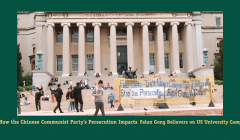How Chinese Censorship is Reaching Overseas
By Sara Cook for CNN (Excerpt) | Jun 09, 2017

Editor’s note: Sarah Cook is a senior research analyst for East Asia at Freedom House and author of report The Long Shadow of Chinese Censorship, which was released October 22 by the National Endowment for Democracy’s Center for International Media Assistance. The views expressed are her own.
China’s leaders, it seems, have become more ambitious in their attempts to control the news.
These are far from the only examples of how the Chinese Communist Party’s media controls extend past China’s borders, in a push documented in a report published last week by the Center for International Media Assistance, which examines a range of media outlets based outside China, from major international media to local outlets in Asia, Africa, and Latin America and elsewhere. And the findings are clear: the “China Factor” looms over newsrooms across the globe.
As the report notes, the pressure has sometimes been overt, with Chinese officials impeding independent reporting by barring foreign correspondents from the sites of significant incidents, pressuring senior executives not to publish content, or simply refusing to issue visas.
But more common – and arguably more effective – has been the carrot and stick approach that induces subtle self-censorship among media owners and outlets. Those perceived as friendly to Beijing might, for example, be rewarded with advertising, access to Chinese audiences, lucrative contracts for non-media enterprises, and even political appointments. Those deemed too critical can face not just visa restrictions for reporters, but lost advertising and blocked websites. As a result, some outlets have become increasingly wary over covering “hot button” issues such as the persecution of Tibetans, Uighurs and Falun Gong practitioners.
…
Indirect pressure can also be applied via proxies, including advertisers, satellite firms, and foreign governments, with out-of-favor outlets likely to be boycotted or have their transmission signals cut.
Thus, it has not only been media organizations themselves that have moved to restrict access to information. Earlier this month, CNN reported that Apple had been accused of “kowtowing to the Chinese government” after “pulling from its China App Store a product enabling users to circumvent firewalls and access restricted sites.” This wasn’t the first time since 2011 that Apple had removed apps that people in China used to access independent overseas Chinese media or bookstores.
…
A more extreme example of how Western businesses can get caught in the middle of transnational Chinese censorship occurred in 2007. Last year, a WikiLeaks cable suggested that Chinese security officials had summoned and interrogated NASDAQ’s chief representative in China, U.S. citizen Lawrence Pan.
According to the cable, the questioning focused on a journalist who had been reporting from the exchange’s New York headquarters for New Tang Dynasty Television (NTDTV), an outlet founded by Falun Gong practitioners in the United States to broadcast news and cultural programming to Chinese audiences. The cable added that Pan, “to secure his release, may have pledged to Chinese authorities that NASDAQ would no longer allow” such access. Indeed, starting in February 2007, NTDTV’s correspondent was suddenly barred from the building after reporting from there on a daily basis for more than a year.
This is an excerpt from CNN. The original article can be found here.










